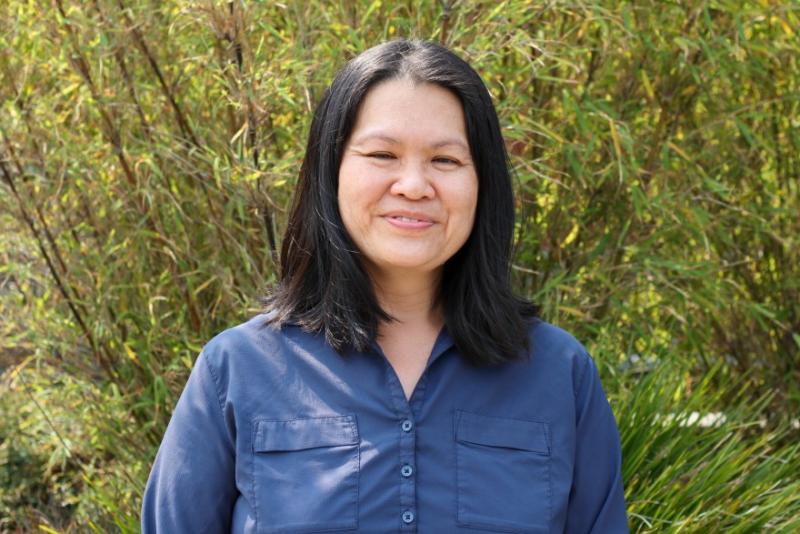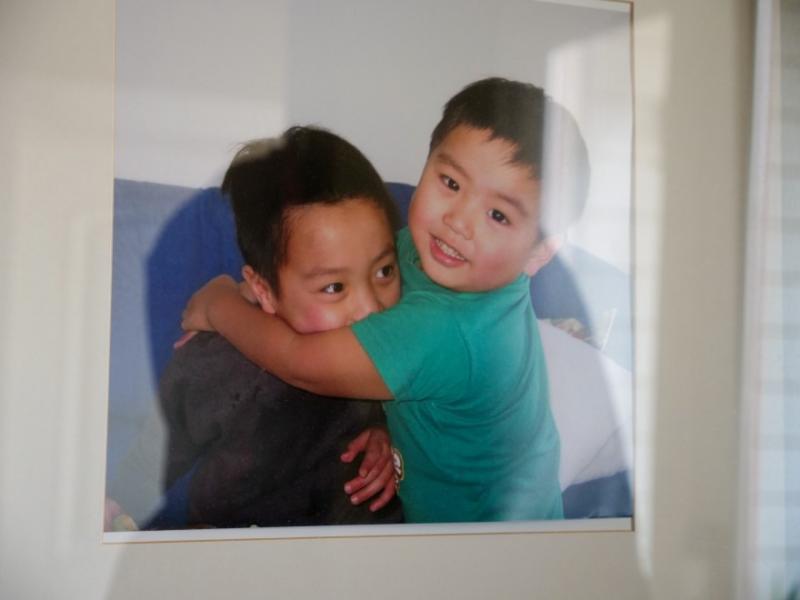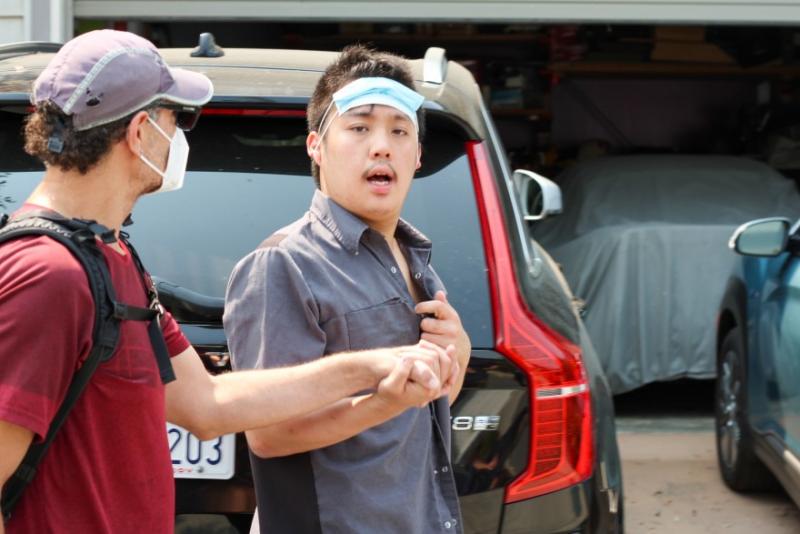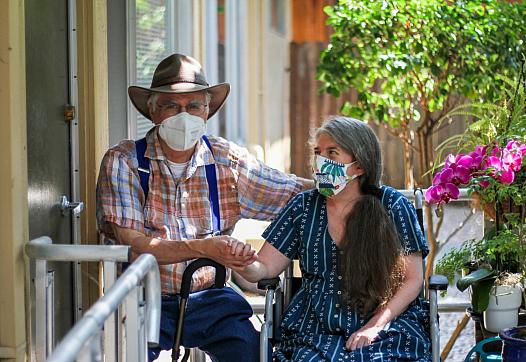COVID-19 Is Exposing The Caregiving Crisis, Leaving Disabled People And Their Families Desperate
Christopher Egusa reported this series while participating in the USC Annenberg Center for Health Journalism's 2021 California Fellowship.
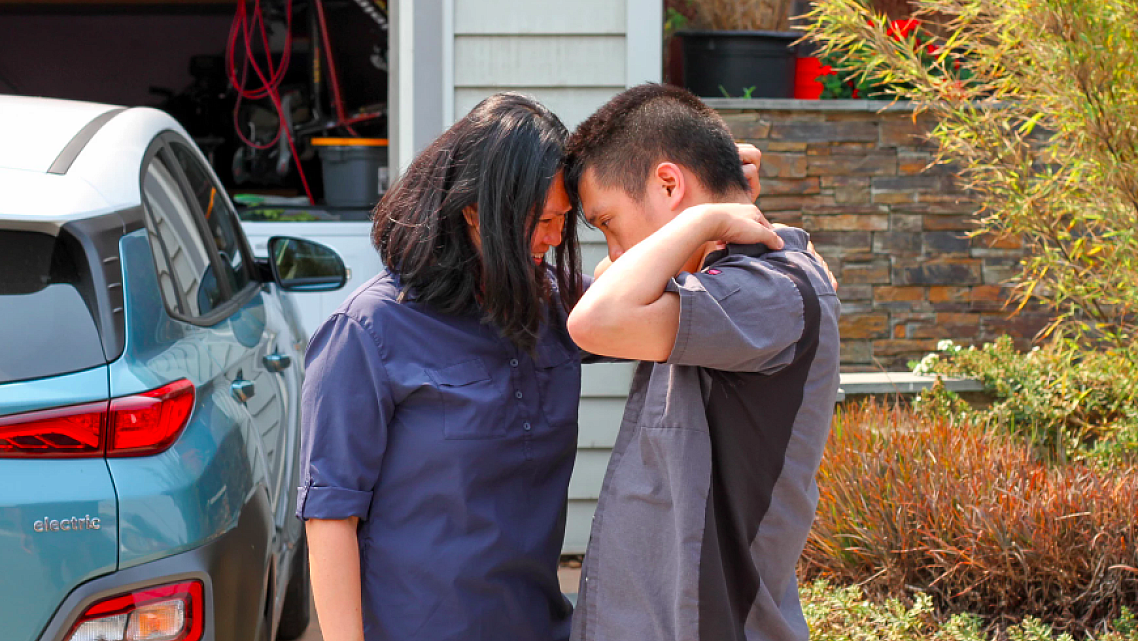
Linus Guok is 21 years old, with a compact frame and hair that’s cropped short on the sides. He leans over a kitchen counter, using a large knife to chop up a pile of produce.
“One of his favorite things is to cut potatoes or sweet potatoes,” his mother, Fiona Wong, explains. “He actually will cut any and everything — like fruits and vegetables — that he sees, which is why we no longer have fruits on the kitchen counter. Because one fine day it got all cut up and there was a big grin on his face!”
Fiona and Linus live near Berkeley, California with dad Chin, and brother Ethan. Linus has severe autism. With it comes a variety of behavioral, social, and medical issues. He’s nonverbal, which means he can vocalize, but isn’t able to use speech, but Fiona says he can understand more than he can speak.
When I visit their home in late July, Linus and his caregiver, Kevin Bernard, are sitting at the kitchen table together. Linus is eagerly taking a pair of scissors to a stack of colorful New Yorker magazines. It’s another one of his favorite hobbies.
Kevin’s been working in this field since the 1980s, and though he first got into it as a side job, he now feels it’s his vocation.
"It's amazing what I've learned from these guys over the years,” he says. “ If you can ease the problems that these guys have in the time that you're with them, that's invaluable.”
Kevin Bernard
He’s only been caretaking for Linus for a few months, but he used to be on staff at an afterschool program Linus attended. So now, after years of working together, the two have developed an unspoken language. Kevin understands what Linus is trying to say from a flick of his head or a subtle gesture.
With Kevin as caretaker, life is the best it's been for Linus and Fiona in 18 months. Only after talking with Fiona did I learn just how desperate things had gotten after their support systems failed.
In her late 40s, Fiona is extremely open — almost disarmingly so. Quick to smile, she’s the kind of person who becomes fast friends with the grocery store clerk. She also has a tendency to laugh at slightly inappropriate times.
“Yeah, I have dark humor and I laugh at these things,” she remarks during one of our conversations.
Fiona and her husband Chin immigrated to the Bay Area from Singapore in the late ‘90s, and had Linus soon after. At two years old he was diagnosed with autism.
“There was an education on my part, to understand: what is his trajectory going to look like?” she says. “There was of course the denial and the ignorance, and then the building of community, and finally the acceptance. It was a long journey.”
That journey hasn’t been easy. Linus isn’t violent or aggressive, but he’s extremely strong-willed. His emotions can easily spiral out of control, ending in tantrums.
And, he doesn’t just have autism. He also has OCD and epilepsy. Without warning, he can be struck by a sudden seizure. It’s sent him to the ER multiple times. The latest was just before the pandemic, when Linus was away at a camp.
Fiona recalls, “The camp counselor thought he had settled in for bed, and so he left the room and then when the night person came, found Linus on the floor bleeding from the head.”
Because of all this, Linus needs 24 hour care and supervision. Even stepping away for a few minutes — like the camp counselor did — can end in disaster.
Despite all these challenges, Fiona and Chin eventually got Linus’ care pretty dialed in.
He attended a special school during the day, and then an afterschool program. Both parents worked full time: Chin as an engineer and Fiona as an occupational therapist. On nights and weekends, Fiona would switch into caregiving mode. It wasn’t easy, but it was working. “We were, like, being parents and also we wanted time with Linus,” she says.
An Endless Pit of Despair
But, in March of last year, the Bay Area announced shelter in place orders, and their lives fell apart. “The school closed, and so did the afterschool programs,” Fiona says. “So we went from having Linus being involved in a program and being engaged and taken care of to nothing at all.”
Because Chin needed to keep working full time, the all-consuming task of taking care of Linus fell to Fiona; every waking moment of every single day. Even just using the bathroom was a challenge.
“You hear the banging on the door, that hollering, and you know, he needs something,” she explains. “So you go to the bathroom, and you come out as soon as you can, and you jump into the chaos of what you need to do to take care of him. He's my son, and of course, I love him. But the human energy can only go so far. And at some point you're exhausted and you feel like there's no end in sight.”
Fiona Wong
As weeks went by and the pandemic showed no signs of slowing down, Fiona realized that something needed to change. She needed help. So, she reached out to the local regional center.
And here’s some background on the complicated world of intellectual and developmental disabilities — or IDD for short.
Regional centers are nonprofits that are funded by the government. There are 21 of them in the state, and they’re supposed to act as a sort of hub for the over 330,000 IDD individuals and families in California. The regional center that Fiona reached out to was the Regional Center of the East Bay.
Here’s how it works: you contact the regional center, and they assign you a case manager who can connect you to the resources you need. So if you tell them you need help with caregiving, the regional center contracts with one of several caregiving agencies in the area to fill that need. At least, that’s how it’s supposed to work.
“But my case manager dropped the ball,” Fiona says. “Because in June, a month later, I emailed her and she had done nothing about it. And she’s like, uh oh… thanks for the reminder.”
At this point, Fiona had already been Linus’ 24/7 caregiver for three months. She’d quit her job to do it full time. She’d reached out to Linus’ school and afterschool program about possible solutions, but her questions were dismissed. And, though she didn’t know it yet, it would be months more before she got help.
Fiona’s mental health began sliding sharply. “I was not dealing with it very well,” she says. “You do the daily thing. So, the feeding and caring and changing his sheets and stuff like that. But it seemed like an endless grind. And I got into a dark place of ‘I don't want to live like this anymore.’”
She describes it as an “endless pit of despair,” which she sunk deeper into each day — with each negative headline and each unanswered call.
In that state, she felt she couldn’t reach out to others for help out of fear of being a burden. One day, though, she did manage to pick up the phone.
“I did call a friend and cried my heart out,” she says. “I said things that made her worry I would take my life. And I had thought about that. And I was in a very dark place.”
Sadly, this is a common story. A June 2021 study from the CDC found that 70% of parents and unpaid caregivers of adults suffered mental health issues during the pandemic, including anxiety, depression, trauma, and suicidal thoughts. In fact, family caregivers like Fiona were eight times more likely to contemplate suicide than others.
Fiona’s friend, now very concerned, called two other friends who are connected to the IDD community, and they immediately had a Zoom intervention with Fiona. They went right into brainstorming mode. Even though they didn’t have all the answers, just the process gave Fiona a spark of hope.
She describes their support as life saving. “It just reminded me that when I think I'm alone, actually, I do have friends who if I knew to call them, they would step in and try to help me.”
With their help, Fiona decided to move Linus to a different school system, and redoubled her efforts to secure a caregiver.
A Revolving Door of Care Workers
Finally, in September 2020 — six months after the lockdown began — she was assigned someone from the caregiving agency, Maxim Healthcare. She says, “We loved her right away. We thought she was a great match. Amazing, life-changing service. From nothing to ‘Oh my God, we have help.’”
She even planned to go back to work. But it didn’t last. After two weeks, the caregiver abruptly stopped showing up. Fiona says, “I got a phone call Monday, Tuesday, Wednesday, and then Thursday, no call and no person.”
It was another month before the agency let her know what happened: the caregiver had had a sudden flareup of chronic illness, and they were trying to find a replacement. From there, it was a series of false starts. Every time Fiona thought maybe they had found something stable, things would go wrong.
A month and a half went by, and a new caregiver started, but she consistently showed up several hours late. And if a caregiver is late, Fiona can’t work.
After a week, Fiona asked for someone new.
Three more weeks; another caregiver. She was great at first, but became inattentive, spent much of her time on her phone, and also started showing up late.
Then, in January, in a cruel twist, the caregiver gave the whole family Covid. Fortunately they all made a full recovery. Fiona can only laugh at the absurdity. “So she gets the first positive test on January 27,” she recalls. “I remember these days, because they’re seared in my mind through trauma.”
The final straw was in May, when the caregiver told Fiona she was leaving for Hawaii a few days later. “I told the coordinator, I think I'm done. I can’t live this way.”
But she largely didn’t have a choice. Fiona says when the agency assigns you a caregiver, it really feels like luck of the draw.
Some families try to get around this by looking for care workers outside of the system. That method has its own complications, but it’s exactly what ended up finally working for Fiona. In May, a friend tipped her off that Kevin, who we met earlier, was in between jobs. It’s not an overstatement to say that Kevin changed their lives.
“He willingly walked into this job knowing how tricky it could be,” she says. “He's reliable, and when he's on he’s on, Kevin is not on his phone. He's like, engaged with Linus. He's actually doing the caregiving and I'm so grateful. I don’t even have the energy to do that.”
The Caregiving Crisis
I’ve gotten to know Fiona as an incredibly upbeat, energetic, and resourceful person. So I had to wonder: what happened in this system? How did things reach such a critical breaking point in Fiona’s life?
To begin understanding, I reached out to Lisa Kleinbub, the Executive Director for the Regional Center of the East Bay, which serves Alameda and Contra Costa counties, where Fiona and Linus live. She told me, “I don't think any of us were prepared for the pandemic in any real way.”
She says the first part of Fiona’s story is really concerning to her — the part about the unresponsive case manager and the month wait time. “That is certainly not what we want,” she says. “We can always work to improve that.
“However, I will say that the story of having to go through a number of different caregivers before you find the one that fits is not unusual… whether there's a pandemic or not a pandemic.”
What Fiona and Linus experienced is a look into the caregiving crisis experts say is looming just on the horizon, and some say is already here. It’s one that will eventually affect anyone who needs care.
The problem starts with basic math. Changing demographics like an aging baby boomer generation means that over the next decade the US is going to need more care workers. Like, 4.7 million more, according to a report by the Paraprofessional Research Institute. That’s the most of any occupation. more than the second and third places combined.
But the number of care workers is actually shrinking, as workers leave the industry. The reason? Caregiving jobs are of such poor quality. Mostly minimum wage or below, offer few benefits, and provide minimal training. Nationally, one in five care workers live below the poverty line, and over half receive public assistance.
“One of the challenges in the Bay Area,” says Lisa, “is just finding people who want to do the kind of direct service work with people who are going to get paid possibly less than they will get to work at a fast food restaurant.”
She says the rates that the regional center can pay caregivers are set by the state legislature, and they’re badly outdated. Some salary levels are still using formulas from the 1990s.
“Having a system that depends on many, many minimum wage workers is not a sustainable system to really serve people in the way they should be served,” she explains.
Kevin, Linus’s caregiver, says he knows plenty of people who have been driven out of the industry simply because they couldn’t make ends meet.
“There really is no way to make it viable if you're not going to offer us a working wage,” he says. “And if you're not going to offer insurance things that people need in order to stay in the field. You need to feel wanted.”
Though they may pay like entry level jobs, caregiving work is demanding and skill-intensive. Kevin has spent years developing his craft.
“You might spend time with Linus and I and not get the nuance of it. If you have no experience in this field, it might seem like we're just cutting potatoes and dribbling a basketball. But if I'm able to understand what the process is and how I'm trying to slow Linus' day down, and get him to be attentive to things and communicate as much as possible, it starts to make sense.”
The end result is an industry that experiences shockingly high turnover. Some estimates put it at over 60%. This is a problem when one of the most important aspects of a caregiver’s work is developing a trusting relationship with their client and learning their specific needs. The revolving door of care workers means that cases like Fiona and Linus get stuck in limbo for months or years, unable to find the consistent care they need.
SEIU Local 2015 is California’s long-term care workers union. In July, President April Verrett spoke at a rally for a national day of action for care workers.
“They told us we were indispensable,” she says to the crowd. “Many of you in this room, you looked death in the face while you put on a mask. And you went out into a plague ravaged nation to care for others.
“So I ask you, isn‘t an essential worker worth more than the minimum wage? Many of us provided care for others during COVID without having healthcare for ourselves or for our families. So I asked you, isn’t a caregiver deserving of care?”
Care workers are 87% women, 49% POC, and almost a third immigrants, and some advocates argue that the poor job quality speaks to a long history of oppression and discrimination.
Kim Evon is the union’s executive vice president. She says, “This was jobs done by black women coming out of, you know, slavery. We've got to start reconciling the fact that people make excuses to pay these women less. It's a leftover part of a racist system.”
She says health insurance and adequate training are some of their priorities. But the big push? “We believe that it is time to make a bold demand. That the minimum floor of any caregiver job, the minimum floor is $20. That it begins to show that… you are demonstrating the value of this work.”
She says their top priority on the national front is the passage of the Biden Administration’s Better Care Better Jobs Act, which would invest $400 billion in home and community based services like caregiving.
“It's a huge part of starting to get to this place that we're talking about. This path to $20, training, healthcare, retirement, this workforce that can really… take care of this growing population of seniors and people with disabilities.”
The goal is for these jobs to be attractive as long term careers.
“Care jobs should be seen as an economic engine in our country,” she says. “And what you reap from it in terms of health outcomes, a growing workforce, a booming economy is… to us, all interconnected.”
But, it’s not enough to just pass the national bill. Kim says it’s also about convincing officials at the state and local levels that this work should be prioritized.
“So… it's up and down the spectrum. Look, dignity isn't a solo act. We all have a part to play in it, and everybody has a way to lean in to make sure it happens.”
Finding a Way to Move Forward
In California, there’s a ray of hope. Governor Gavin Newsom recently approved an almost $90M funding increase to help regional centers pay care workers and other service providers higher rates. The number falls far short of the at least $1.8B that’s needed, but it’s scheduled to increase in the coming years.
Ultimately, what all this could mean for people like Fiona and Linus is some semblance of consistency. Kevin has been a godsend for them, but there’s no guarantee how long he’ll be able to work with Linus.
Fiona says if not for him, she “would still be in this cycle of maybe having a mismatch of a provider and only having her or him only last a few weeks, you know, and then it's onto the next provider. I would be pulling my hair out.”
Years of being the default caregiver have taken their toll. “It's a tough place to be for an extended period of time. It's difficult to get self worth and validation, when you're putting others first constantly is exhausting,” she says.
Besides using her dark humor to cope, she says she has certain memories that she likes to revisit. One of them is from when Linus was in kindergarten. The speech therapist was trying to get him to nod his head. He couldn’t do it, so “Linus would take his hands, hold his head and move up and down,” she explains as she gestures with her hands. “So he had to physically hold his head to nod!” she explains.
”It's like, it's a funny thing that he did. That makes me smile every time. But it also speaks to his character, his personality, which we have seen through the years. Whether good or bad, he has a tenacity about him to go do the thing. He is determined, yes, it is hard to stop that tornado destined to go that direction.”
That tenacity has been the source of so many headaches, exasperated sighs, and frustrated hands flung in the air. But it’s also what she loves about Linus.
And it’s a trait that they share. It got them through the darkest months of the pandemic, and she’s trusting it to get them through whatever’s next.
Christopher Egusa reported this series while participating in the USC Annenberg Center for Health Journalism‘s 2021 California Fellowship.
[This article was originally published by KALW].


